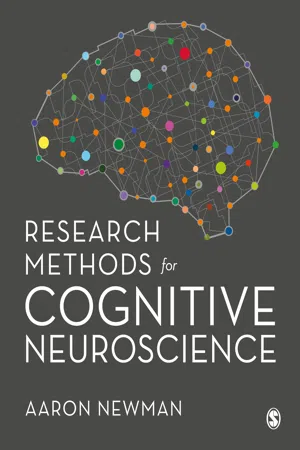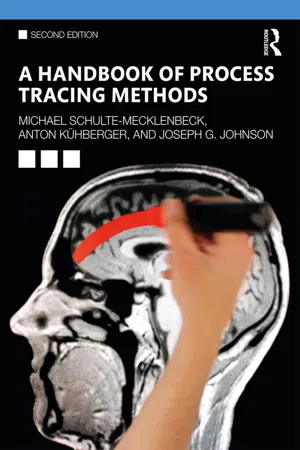Electroencephalogram (EEGs) and Event-Related Potentials (ERPs)
Electroencephalogram (EEG) is a non-invasive technique that records electrical activity in the brain, providing information about brain function and activity. Event-Related Potentials (ERPs) are specific patterns in the EEG that are time-locked to sensory, cognitive, or motor events, allowing researchers to study cognitive processes such as attention, memory, and perception.
8 Key excerpts on "Electroencephalogram (EEGs) and Event-Related Potentials (ERPs)"
- eBook - ePub
- Aaron Newman(Author)
- 2019(Publication Date)
- SAGE Publications Ltd(Publisher)
...440) and concluded that these waves corresponded ‘to a summation of the brief responses of individual neurones’ (p. 471). Soon after, the first event-related potentials (ERPs – sometimes also called evoked potentials or EPs) were recorded by Pauline and Hallowell Davis (Davis, Davis, Loomis, Harvey, & Hobart, 1939; Davis, 1939). The distinction between EEG and ERP is an important one in the field, and quite simply EEG refers to continuous recordings of ongoing electrical brain activity, whereas ERPs are EEG signals time-locked to particular events, such as the presentation of a specific stimulus or a motor response. As we will see, both EEG and ERPs are used in cognitive neuroscience; however, ERPs are the more commonly used technique because they allow us to associate brain activity with specific, experimentally controlled events. As this is the first chapter describing a neuroimaging technique, a number of key concepts are introduced that are common to many, if not all, techniques of cognitive neuroscience and so we will spend some time explaining these concepts. Rest assured, the time invested understanding concepts of data acquisition and signal processing will serve you well in chapters to come. What Are We Measuring? Physiological Basis of the EEG Signal EEG is recorded from electrodes (typically numbering 3–256) placed on the scalp, which are connected to an amplifier that boosts the size of the signals before saving them digitally on a computer, as shown in Figure 3.1. EEG can also be recorded directly from the cortical surface via electrodes placed during neurosurgery, but in this chapter we focus on non-invasive recordings. The EEG electrodes measure electrical activity generated by the brain; however, we cannot measure the activity of individual neurons. This is because the brain contains millions of neurons, located relatively far away from the EEG recording electrodes. Rather, the EEG signal represents the summed activity of many neurons...
- Jill Jegerski, Bill VanPatten(Authors)
- 2013(Publication Date)
- Routledge(Publisher)
...6 Event-Related Potentials (ERPs) Kara Morgan-Short and Darren Tanner History of the Method The first reports of human brain activity recorded at the scalp were made by Hans Berger (Berger, 1929). Berger showed that by placing an electrode on the scalp and amplifying the data, a series of positive and negative voltage fluctuations could be seen. Although it took a number of years before the broader community replicated and accepted Berger’s findings as reflecting brain activity, recordings of the human electroencephalogram (EEG) have since provided an exceptionally rich source of information on human cognition and, since the 1980s, on the processing and learning of language. After the initial reports of the EEG, it was several decades before EEG was seriously used to study cognition, perhaps for at least two reasons. First, the EEG in its raw form is relatively uninformative about specific neural or cognitive processes, as it reflects the summation of hundreds of (and likely many more) neural sources acting simultaneously. This makes the activity related to any specific event or process difficult to see in the raw waveform. Second, the relative expense and low power of computers in the early EEG era made higher-level quantification and analysis of EEG data infeasible. However, isolating activity relevant to specific cognitive processes is not an intractable problem. Embedded within the raw EEG are distinct signals associated with many of the ongoing processes in the brain, and some of them can be extracted using simple averaging procedures. That is, by averaging the EEG signal over numerous trials in a given experimental condition, the fluctuations in EEG activity that are time- and phase-locked to the presentation of the stimuli can be identified. The resulting waves thus reflect the brain’s electrical activity associated with a specific cognitive event...
- eBook - ePub
Psychophysiology
Human Behavior & Physiological Response
- John L. Andreassi(Author)
- 2013(Publication Date)
- Psychology Press(Publisher)
...5 Event-Related Brain Potentials and Behavior I: Measurement, Motor Activity, Hemispheric Asymmetries, and Sleep Another measure of brain activity, derived from EEG recordings, is the event-related brain potential (ERP). Unlike the EEG, which represents spontaneous brain activity, the ERP is generated as a response to specific stimuli, and is an average of a number of samples. These ERPs are time-locked to stimulus events and have proven valuable to the psychophysiologist interested in a record of brain responses to stimuli, even when no other noticeable response occurs. A great deal of research effort has been devoted to studying the relationship between ERPs and human psychological activities. Most of the work has been conducted over the past 35 years and is continuing at a high rate. What makes the ERP so appealing is the possibility of relating specific brain responses to discrete psychological states and events. The extensive research on ERPs indicates that it rivals heart activity as the most popular physiological variable studied by psychophysiologists. The ERP has been found to be dependent on both physical and psychological characteristics of stimuli, although in some instances, ERPs are independent of specific stimuli. For example, brain responses have been found to occur at the precise time that stimuli were expected but not actually presented (Sutton, Teuting, Zubin, & John, 1967). When ERPs occur independently of external stimuli, they are called endogenous, indicating that they are produced by internal events. Those ERPs produced as a reaction to specific external events are called exogenous potentials. Vaughan (1969) proposed the term event-related potentials to refer to a variety of brain responses that show stable time relationships to actual or anticipated stimuli...
- eBook - ePub
Psychophysiology
Human Behavior and Physiological Response
- John L. Andreassi(Author)
- 2010(Publication Date)
- Psychology Press(Publisher)
...6 Event-Related Brain Potentials and Behavior I: Measurement, Motor Activity, Hemispheric Asymmetries, and Sleep Another measure of brain activity, derived from EEG recordings, is the event-related brain potential (ERP). Unlike the EEG, which represents spontaneous brain activity, the ERP is generated as a response to specific stimuli, and is an average of a number of samples. These ERPs are time locked to stimulus events and have proven valuable to the psychophysiologist interested in a record of brain responses to stimuli, even when no other noticeable response occurs. A great deal of research effort has been devoted to studying the relationship between ERPs and human psychological activities. Most of the work has been conducted over the past 40 years and is continuing at a high rate. What makes the ERP so appealing is the possibility of relating specific brain responses to discrete psychological states and events and obtaining a more complete picture of the behavior being studied. The extensive research on ERPs indicates that it rivals heart activity as the most popular physiological variable studied by psychophysiologists and neuroscientists. The ERP has been found to be dependent on both physical and psychological characteristics of stimuli, although in some instances, ERPs are independent of specific stimuli. For example, brain responses have been found to occur at the precise time that stimuli were expected but not actually presented (Sutton, Teuting, Zubin, & John, 1967). When ERPs occur independently of external stimuli they are called endogenous, indicating that they are produced by internal events. Those ERPs produced as a reaction to specific external events are called exogenous potentials. Vaughan (1969) proposed the term event-related potentials to refer to a variety of brain responses that show stable time relationships to actual or anticipated stimuli...
- eBook - ePub
- Michelle de Haan, Michelle de Haan(Authors)
- 2013(Publication Date)
- Psychology Press(Publisher)
...7 The use of event-related evoked potentials to predict developmental outcomes Dennis L. Molfese, Victoria J. Molfese and Nikki L. Pratt University of Louisville, Kentucky, USA DOI: 10.4324/9780203759660-8 There is great interest by researchers, clinicians, educators, and parents in understanding brain functioning and cognitive skill development. This interest has been heightened by the development of methodologies for measuring brain responses that have revealed differences between typically developing and at-risk or disabled children. Some useful and relatively new techniques for studying the cognitive skills include event-related potentials (ERPs) that use scalp electrodes to detect electrical activity generated by neurons in the brain. These brain responses, in turn, can be related to behavioral measures to look for reliable commonalities useful for understanding how brain mechanisms correspond to behavior. The purpose of this chapter is to review the use of ERP techniques in research to better understand how brain–based responses can be systematically related to developmental changes in specific cognitive skills. From this review it should be clear that the ERP technique provides insights into brain–behavior development that complements and supplements information obtained through more traditional behavioral measures. ERPs Index Speech Perception Early studies using ERP measures focused on the more general issue of whether brain responses reflected discriminations of speech compared to non-speech sounds and whether such discriminations were accompanied by differences in the responding of the two brain hemispheres to these stimuli (Cohn, 1971 ; Friedman, Simson, Ritters, & Rapin, 1975 ; Galambos, Benson, Smith, Schulman-Galambos, & Osier, 1975 ; Jaramillo, Ilvonen, Kujala, Alku, Tervaniemi, & Alho, 2001 ; Kayser, Tenke, & Bruder, 1998 ; Molfese, Freeman. & Palermo, 1975 ; Morrell & Salamy, 1971 ; Neville, 1974)...
- eBook - ePub
A Handbook of Process Tracing Methods
2nd Edition
- Michael Schulte-Mecklenbeck, Anton Kuehberger, Joseph G. Johnson, Michael Schulte-Mecklenbeck, Anton Kuehberger, Joseph G. Johnson(Authors)
- 2019(Publication Date)
- Routledge(Publisher)
...14 EEG and ERPs as Neural Process Tracing Methodologies in Decision-Making Research 1 Mary E. Frame EEG as a Process Tracing Method The goal of any process tracing method is to observe cognition in action, given technological constraints. There has also been increased appreciation for the usefulness of understanding human biology and brain activity as it relates to all cognitive activity, including decision making. As researchers pursue this goal, it is important to implement methods that are safe and noninvasive while still providing a rich source of data to measure information acquisition, fluctuations in preference, and implementation of action in a temporally precise manner. Temporal precision and noninvasiveness are two of the strengths of utilizing electroencephalography (EEG) in the study of the neural and biological bases of decision making. Although there are many ways of studying EEG activity, two particular approaches have become popular for studying the neural correlates of the decision-making process: 1) spectral analysis, which attempts to decompose EEG signals into their component sine waves and examine particular bands of activity that are correlated with cognitive processes, and 2) Event Related Potentials (ERPs), which are averaged series of EEG activity time locked to a particular event, such as the onset of a stimulus or the execution of a response. This chapter will provide a broad description of the value added by examining both of these process tracing methods, contributions that have been made to the field of decision making, and a brief future outlook for additional process tracing techniques using EEG and ERPs. Value Added by Studying Brain Activity Although other process tracing metrics such as eye-tracking (see Chapters 1 – 5) and mouse-tracking (see Chapters 9 – 10) are capable of elucidating the decision-making process online, there is added benefit to examining dynamic brain activity...
- eBook - ePub
- Michael D. Rugg, Michael D. Rugg(Authors)
- 2013(Publication Date)
- Psychology Press(Publisher)
...The chapter starts with a few references to some basics of electrical (event-related potentials (ERP s)) and magnetic (event-related fields (ERF)) recording. This is followed by a short tutorial on the physiology and physics of electrical and magnetic activity, a discussion of the types of inference that can and cannot be drawn from such measurements, and a cursory overview of the most widely used terms in cognitive electrophysiology. We conclude with a few specific examples of cognitive ERP and ERF research. 7.1 Event-related activity: Electrical (ERPS) and magnetic (ERFS) An ERP/ERF experiment requires a willing participant, electrodes for recording the brain wave activity or a magnetometer, some means of presenting stimuli, amplifiers and a digitizer that turns the analogue data into a digital form for storage, further representation and analyses. Technical details about electrodes, electrode placement, amplifiers, magnetic recordings, digitization and analyses can be found in a number of articles and books (Cooper et al. 1974, Regan 1989, Hamalainen et al. 1993, Rugg & Coles 1995). There are many ways to look at electrical and magnetic activity in both the temporal and spatial domains. The emphasis of this chapter is on scalp activity, specifically that which is time-locked or synchronized to some external stimulus or event. Typically, the earliest or so-called “exogenous” components of the ERP are used in a clinical setting to assess the integrity of the peripheral or central nervous system, although they are clearly essential for understanding cognitive effects as well (for more in-depth discussion see Desmedt 1988, Starr & Don 1988, Regan 1989). Since the evoked response to a single stimulus at the scalp is quite small (5–10μV), it must be extracted from the background activity via averaging...
- eBook - ePub
Aptitude, Learning, and Instruction
Volume 2: Cognitive Process Analyses of Learning and Problem Solving
- Richard E. Snow, Pat-Anthony Federico, William E. Montague(Authors)
- 2021(Publication Date)
- Routledge(Publisher)
...For more details and for a consideration of the entire gamut of ERP studies, the reader may consult the summaries presented in Callaway, Tueting, and Koslow (1978). In the following pages, we first review some of the background that is necessary for understanding ERP studies, and we introduce some of the ERP components. We then discuss data supporting the assertion that both the amplitude and the latency of the P300 component can be used to study the subject’s cognitions. Event-Related Brain Potentials The event-related brain potential is a transient response to specific events that is embedded within the human electroencephalogram (EEG). Without the aid of signal-extraction techniques, these potentials are difficult to detect in scalp recordings, as the magnitude of the ERP may be considerably smaller than the magnitude of the ongoing EEG. The development of digital signal averagers in the late 1950s (Clynes & Kohn, 1960) made it possible to obtain useful estimates of the ERP. Figure 16.1 illustrates the utilization of signal averaging to extract from the EEG the brain response to a tone. In panel A are shown several individual records of EEG. The records are aligned by the time of presentation of a brief tone. It is clearly impossible to see a consistent response to the tone in the individual records. In panel B, photographs of 60 of such single trials are superimposed. This superimposition technique was pioneered by Dawson (1954) in England. This procedure enhances aspects of the data that are consistent across the trials. Thus voltage changes that are time-locked to the stimulus should be emphasized by the superimposition. A consistent negative-positive pattern indeed appears immediately following the tone. A more refined estimate of the ERP is obtained when a signal average is computed, as seen in panel C. The voltage oscillations of the ongoing EEG are not time-locked to the tones and tend to average out, leaving the signal, or ERP...







